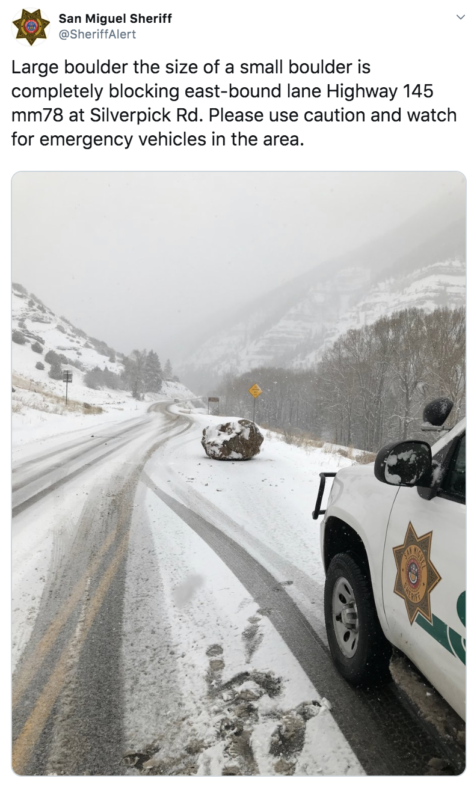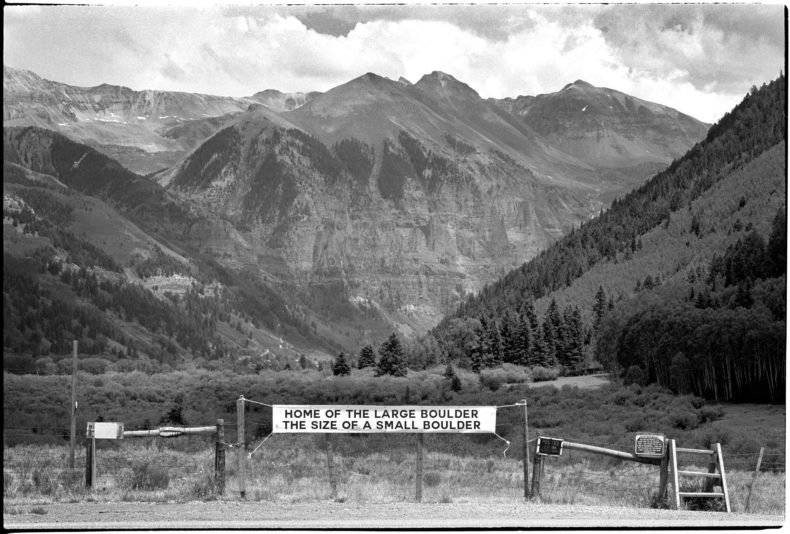
This happened the other day not far from where I live. Boulders fall all the time around here, highways regularly blocked. This time, the wording is what stuck.
The local sheriff’s post went viral when this fallen obstacle was described as a “large boulder the size of a small boulder.” With those words, this 10,000-pound rock sprung to greater fame than the pair of multi-million-pound sandstone monuments that fell a thousand feet onto a highway the next county over last spring, rectified with dynamite and a change in the highway’s course.
This new one, of lesser size than its greater self, was scraped to the side with basic road equipment, yet it has become celebrated, appearing on the the Colbert Report, a bit of fame for our corner of Colorado. It is a roughly roundish hulk of what looks like limestone, the size, I’d say, of two polar bears hugging.
I’ve spent a career describing the size of boulders. A desert author from exposed terrain, I can hardly get through a page without using the word. Once you use it, you need a comparison. No one wants to envision an object the size of a TV when it’s as big as a dump truck.
In common usage, a boulder is a rock fragment a person cannot move by hand. A lever, bulldozer, crane, or many hands are required. As Stephen Colbert said about the boulder in question, “To move that, they’re going to need a medium size crane the size of a huge crane.”
In geologic terms, a boulder starts at 25.6 cm in diameter, the size of a basketball, and beyond that the sky’s the limit.
A boulder like the one that landed on the highway is technically considered sediment. Anything that breaks away from the greater mass of the earth is sediment. These broken pieces are organized into clay, silt, sand, granule, pebble, cobble, and boulder. Clay and silt are too small to measure with the eye, best described by touch, e.g., slick to gritty. Sand you can detect as individual grains between your fingers, up to 2 millimeters in diameter, which would be the head of a pin. Granules go up to the size of a bb at 4 mm. Pebbles range from what you’d find in a box of Grape-nuts to 64 mm, slightly larger than a ping pong ball. A cobble goes from there to a rock you can hold in two hands, which is the starting dimension of a boulder, 25.6 cm across.
Boulder is the largest of the sediments. It has no defined upper limit. Technically, the moon is a boulder, right?
When one lands in the highway and needs to be reported, you can’t just say it’s a boulder. Susan Lilly, Public Information Officer for the San Miguel County Sheriff, wrote the post that started all this. She is also a local search and rescue volunteer in a county absolutely strewn with boulders from its highest point at 14,023 feet down to 5,308 feet in the desert below. Let’s say every square yard in this absurdly rocky county has a boulder, which, on average, is probably true. At 1,289 square miles, this adds up to about 4 billion boulders.
That is more boulders than objects to compare them to.
When Lilly put out her statement, calling this highway obstruction a large boulder the size of a small one, I and many others were gleeful. Lilly posted the next day, “I own my mistake, now I rock it.”
Mistake? I think not. That boulder is, indeed, a small version of a larger version of itself. Lilly’s description is existentially perfect. This is a piece of geology, a spall of the planet Earth. It will eventually become rubble, down to ping pong ball, grape-nut, sand grain, and facial scrub. It is small and large at once. It is a boulder.

Photos: upper, San Miguel County Sheriff; lower, photoshop creation by Ben Knight
I’m guessing she meant small car, but had boulders on the mind. Seems like you need a few different words for boulders that can be moved by hand (i.e. by rolling them), ones that need reasonable machinery, and those where it’s easier to just move the road instead. Like places where it rains more often will have more words for different types of rain, a place with more boulders should have more words words for them.
Can I just say you had me at two polar bears hugging? It gets better from there, though! Susan Lilly rocks, both for volunteering to do search and rescue and for having an amazing sense of humor! I don’t even know her, but still! Then, when you got to existential perfection… wow. I kinda wish I were a boulder. Also, Neil (above) is right; how can we go straight from rock that you can hold to boulder (basketball-Moon sizes)? More words are needed.
Reminds me of a sign that read, “Closed due to closure”.